Sustainability of Underground Hydro-Technologies: From Ancient to Modern Times and toward the Future
Abstract
:1. Introduction
1.1. Aqueducts
1.2. Qanats
1.3. Associated Hydraulic Structures
1.4. Sustainability
2. Underground Hydro-Technologies in Prehistoric Times (3200 BC–1000 BC)
2.1. Ancient Egypt
2.2. Minoan and Mycenaean Civilizations
3. Underground Hydro-Technologies in Historical Times (1000 BC–330 AD)
3.1. Assyrian and Achaemenid Aqueducts and Qanats
3.2. Archaic, Classical and Hellenistic Greece
3.3. Roman Aqueducts and Cisterns
3.4. Petra
4. Underground Hydro-Technologies in Medieval Times (ca 330–1400 AD)
4.1. Byzantium
4.2. Crusaders
4.3. Puquios of Nazca (Peru)
4.4. Karez of Central Asia
5. Underground Hydro-Technologies in Early- and Mid-Modern Times (ca 1400–1900 AD)
6. Underground Hydro-Technologies in Contemporary Times (1900 AD–Present)
7. Emerging Trends and Future Issues and Challenges on Sustainability
8. Conclusions
Author Contributions
Funding
Acknowledgments
Conflicts of Interest
References
- Voudouris, K.; Christodoulakos, Y.; Stiakakis, M.; Angelakis, A.N. Hydrogeological Characteristics of Hellenic Aqueducts-like qanats. Water 2013, 5, 1326–1345. [Google Scholar] [CrossRef] [Green Version]
- Barghouth, J.M.; Al-Sa`ed, R.M.Y. Sustainability of Ancient Water Supply Facilities in Jerusalem. Sustainability 2009, 1, 1106–1119. [Google Scholar] [CrossRef] [Green Version]
- Angelakis, A.N.; Mays, L.W.; De Feo, G.; Salgot, M.; Laureano, P.; Drusiani, R. Topics and Challenges on Water History. In Global Trends & Challenges in Water Science, Research and Management: A compendium of hot topics and features from IWA Specialist Groups, 2nd ed.; Li, H., Ed.; IWA: London, UK, 2016; pp. 128–132. [Google Scholar]
- Wessels, J.I.; Weingartner, H.; Eslamian, S.; Angelakis, A.N. Underground Aqueducts: Past, Present, and Future Trends. In Underground Aqueducts Handbook; CRC Press, Taylor & Francis Group: Boca Raton, FL, USA, 2016; pp. 491–509. [Google Scholar]
- De Feo, G.; Laureano, P.; Mays, L.W.; Angelakis, A.N. Water Supply Management Technologies in the Greek and Roman Civilizations. In Evolution of Water Supply throughout Millennia; IWA Publishing: London, UK, 2012; pp. 351–382. [Google Scholar]
- Weingartner, H. Water Supply by qanats: A Contribution to Water Shortage in Mediterranean Areas. In Proceedings of the 10th International Conference on Environmental Science and Technology, Kos Island, Greece, 5–7 September 2007; pp. 1555–1561. [Google Scholar]
- Parise, M.; Marangella, A.; Maranò, P.; Sammarco, M.; Sannicola, G. Collecting, transporting and storing water in karst settings of southern Italy: Some lessons learned from ancient hydraulic systems. Water Sci. Technol. 2013, 13, 674–682. [Google Scholar] [CrossRef]
- Ahmed, A.T. Water Quality for Irrigation and Drinking Water Use of Aflaj in Oman. Water Sci. Technol. 2015, 15, 421–428. [Google Scholar] [CrossRef]
- Cartwright, M. “Aqueduct”. Ancient History Encyclopedia, 1 September 2012. Available online: https://www.ancient.eu/aqueduct/ (accessed on 13 March 2020).
- Beaumont, P. Qanat systems in Iran. Hydrol. Sci. J. 1971, 16, 39–50. [Google Scholar] [CrossRef]
- Goblot, H. Les Qanats, une Technique D’acquisition de l’eau/English: Qanat a Technique for Obtaining Water; Ecole des Hautes en Sciences Sociales: Paris, France, 1979; p. 236. [Google Scholar]
- Yazdi, S.; Asghar, A.; Khaneiki, M.L. Qanat Knowledge: Construction and Maintenance; Springer: Dordrecht, The Netherlands, 2017. [Google Scholar]
- English, P.W. The origin and spread of qanats in the Old World. Proc. Am. Philos. Soc. 1968, 112, 170–181. [Google Scholar]
- Al-Taiee, T.M. Kahrezes (Qanats) A ground water harvesting technology in arid and semi-arid regions. In Proceedings of the 3rd IWA Specialized Conference on “Water and Wastewater Technologies in Ancient Civilizations”, Istanbul, Turkey, 22–24 March 2012; pp. 14–22. [Google Scholar]
- Parise, M.; Abbasnejad, A.; Abbasnejad, B.; Derakhshani, R.; Hemmati, S.A. Qanat is not a hazard. Rebuttal to Qanat hazard in Iranian urban areas: Explanation and remedies. Environ. Earth Sci. 2016, 75, 1306. [Google Scholar]
- English, P.W. City and Village in Iran: Settlement and Economy in the Kirman Basin; University of Wisconsin Press: Madison, WI, USA, 1966. [Google Scholar]
- Bonine, M.E. The morphogenesis of Iranian cities. Ann. Assoc. Am. Geogr. 1979, 69, 208–224. [Google Scholar] [CrossRef]
- Bonine, M.E. From qanat to kort: Traditional irrigation terminology and practices in central Iran. Br. Inst. Persian Stud. 1982, 20, 145–159. [Google Scholar] [CrossRef]
- Himat, A.; Dogan, S. Ancient karez systems as a sustainable tool for irrigation and water supply in rural Afghanistan. Int. J. Ecosyst. Ecol. Sci. 2017, 7, 269–274. [Google Scholar]
- Wessels, J. Reviving ancient water tunnels in the desert—Digging for gold? J. Mt. Sci. 2005, 2, 294–305. [Google Scholar] [CrossRef]
- Mays, L.W. Lessons from the ancients on water resources sustainability. In Ancient Water Technologies; Springer: Dordrecht, The Netherlands, 2010; pp. 217–239. [Google Scholar]
- Gleick, P.H. The World’s Water, The Biennial Report on Freshwater Resources; Island Press: Washington, DC, USA, 2005. [Google Scholar]
- Gleick, P.H.; Loh, P.; Gomez, S.; Morrison, J. California Water 2020: A Sustainable Vision; Pacific Institute for Studies in Development, Environment and Security: Oakland, CA, USA, 1995. [Google Scholar]
- Ahmed, A.T.; Elsanabary, M.H. The water supply history of underground aqueducts in Egypt. In Underground Aqueducts Handbook; CRC Press: Boca Raton, FL, USA, 2016. [Google Scholar]
- Koutsoyiannis, D.; Zarkadoulas, N.; Angelakis, A.N.; Tchobanoglous, G. Urban water management in Ancient Greece: Legacies and lessons. ASCE J. Water Resour. Plan. Manag. 2008, 134, 45–54. [Google Scholar] [CrossRef] [Green Version]
- Voudouris, K.; Tsatsanifos, C.; Yannopoulos, S.; Angelakis, A.N. Evolution of Underground Aqueducts in the Hellenic World. Water Sci. Technol. 2016, 16, 1159–1177. [Google Scholar] [CrossRef] [Green Version]
- Evans, A. The Palace of Minos at Knossos: A Comparative Account of the Successive Stages of the Early Cretan Civilization as Illustrated by the Discoveries; Macmillan and Co.: London, UK, 1921; Reprinted by Biblo and Tannen: New York, NY, USA, 1962; Volume 1–4, pp. 1921–1935. [Google Scholar]
- Tsatsanifos, C. Ancient Greek Geotechnical Successes. In Proceedings of the during the ISSMGE European Members Meeting during the XIV ECSMGE, Madrid, Spain, 20–24 October 2007. [Google Scholar]
- Cistern of Ancient Mycenae. Mikinai—Mikines—Mykenai. 2020. Available online: https://www.showcaves.com/english/gr/subterranea/Mycenae.html (accessed on 7 May 2020).
- Nordin, J.P. The Ancient City of Mycenae. 2004. Available online: https://theplaka.com/mycenae/index.htm (accessed on 7 May 2020).
- Margat, J.; Van der Gun, J. Groundwater around the World: A Geographic Synopsis; CRC Press/Balkema: Leiden, The Netherlands, 2013; p. 343. [Google Scholar]
- Pappas, A. Water Supply of Ancient Athens (Η Ύδρευσις των Αρχαίων Αθηνών). Ελεύθερη Σκέψις; University Microfilm International: Athens, Greece, 1999. (In Greek) [Google Scholar]
- Chiotis, D.E.; Chioti, E.L. Water supply of Athens in the antiquity. In Evolution of Water Supply through the Millennia; IWA: London, UK, 2012; pp. 407–442. [Google Scholar]
- Valipour, M. Assessment of important factors for water resources management in European agriculture. J. Water Resour. Hydraul. Eng. 2015, 4, 171–180. [Google Scholar] [CrossRef]
- Voudouris, K.; Valipour, M.; Kaiafa, A.; Zheng, X.Y.; Kumar, R.; Zanier, K.; Kolokytha, E.; Angelakis, A. Evolution of water wells focusing on Balkan and Asian civilizations. Water Supply 2019, 19, 347–364. [Google Scholar] [CrossRef]
- Angelakis, A.N.; Koutsoyiannis, D. Urban Water Engineering and Management in ancient Greek times. In The Encyclopedia of Water Science; Dekker: New York, NY, USA, 2003; pp. 999–1007. [Google Scholar]
- Parker, J.H. The Aqueducts of Ancient Rome; Kessinger Publishing: Oxford, UK, 1876. [Google Scholar]
- Kastenbein, T.R. Archeologia Dell’Acqua: La Cultura Idraulica nel Mondo Classico; Longanesi & C.: Milano, Italy, 1993; p. 278. [Google Scholar]
- Stephens, C.R. The walls and aqueducts of Rome in the early middle ages. J. Roman Stud. 1998, 88. [Google Scholar] [CrossRef]
- Blackman, D.R. The volume of water delivered by the four great aqueducts of Rome. In Papers of the British School at Rome; Cambridge University Press: Cambridge, UK, 1979; p. 46. [Google Scholar]
- Delle Rose, M.; Giuri, F.; Guastella, P.; Parise, M.; Sammarco, M. Aspetti archeologici e condizioni geologico-morfologiche degli antichi acquedotti pugliesi. L’esempio dell’acquedotto del Triglio nell’area tarantina. Opera Ipogea 2006, 1–2, 33–50. [Google Scholar]
- De Marco, M.; Guastella, P.; Marangella, A.; Parise, M. L’antico acquedotto romano del Saturo-Leporano (Taranto, Puglia). Opera Ipogea 2008, 1–2, 107–116. [Google Scholar]
- Cano-Hurtado, J.J.; Canto-Perello, J. Sustainable development of urban underground space for utilities. Tunn. Undergr. Space Technol. 1999, 14, 335–340. [Google Scholar] [CrossRef]
- Ashby, T. The Aqueducts of Ancient Rome; Clarendon Press: Oxford, UK, 1935. [Google Scholar]
- Judson, S.; Kahane, A. Underground drainageways in southern Etruria and northern Latium. In Papers of the British School at Rome; Cambridge University Press: Cambridge, UK, 1963; Volume 31, pp. 74–99. [Google Scholar]
- Hodge, A.T. Roman Aqueducts and Water Supply; Bloomsbury Publishing PLC: London, UK, 1992. [Google Scholar]
- Parise, M.; Galeazzi, C.; Germani, C.; Bixio, R.; Del Prete, S.; Sammarco, M. The map of ancient underground aqueducts in Italy: Updating of the project, and future perspectives. In Proceedings of the International Congress in Artificial Cavities “Hypogea 2015”, Rome, Italy, 11–17 March 2015; pp. 235–243. [Google Scholar]
- Parise, M.; Sammarco, M. The historical use of water resources in karst. Environ. Earth Sci. 2015, 74, 143–152. [Google Scholar] [CrossRef]
- Gausmann, R. Water for Athens; Gennadius Library: Athens, Greece, 1940. [Google Scholar]
- Curiel-Esparza, J.; Canto-Perello, J.; Calvo, M.A. Establishing sustainable strategies in urban underground engineering. Sci. Eng. Ethics 2004, 10, 523–530. [Google Scholar] [CrossRef]
- Travlos, J. Pictorial Dictionary of Ancient Athens; Hacker Art Books: New York, NY, USA, 1980. [Google Scholar]
- Hekimoglou, E. Ydatini Istoriografia (Υδάτινη Ιστοριογραφία) EYDAP; University Microfilm International: Athens, Greece, 2014. (In Greek) [Google Scholar]
- Maranò, P. Il Problema Acqua a Grottaglie: Sistemi di Raccolta Dell’Acqua Piovana. Bachelor’s Thesis, Faculty of Architecture, University of Florence, Florence, Italy, 2005–2006. [Google Scholar]
- De Feo, G.; De Gisi, S.; Malvano, C.; De Biase, O. The greatest water reservoirs in the ancient Roman world and the “Piscina Mirabilis” in Misenum. In Proceedings of the International Water Association Specialty Conference, 2nd International Symposium on “Water and wastewater technologies in ancient civilizations”, Bari, Italy, 28–30 May 2009. [Google Scholar]
- Parise, M.; Marangella, A.; Maranò, P.; Sammarco, M.; Sannicola, G. Ancient Hydraulic Systems for Collection, Transport, and Storage of Water in Karst Settings of Southern Italy. In Proceedings of the IWA Specialized Conference on Water & Wastewater, Istanbul, Turkey, 22–24 March 2012. [Google Scholar]
- Mays, L.W. Use of cisterns during antiquity in the Mediterranean region for water resources sustainability. Water Sci. Technol. 2014, 14, 38–47. [Google Scholar] [CrossRef]
- Alkaff, S.A.; Sim, S.C.; Efzan, M.E. A review of underground building towards thermal energy efficiency and sustainable development. Renew. Sustain. Energy Rev. 2016, 60, 692–713. [Google Scholar] [CrossRef]
- Milstein, M. “Lost City” of Petra Still Has Secrets to Reveal. Nationalgeo-graphic. Available online: http://science.nationalgeographic.com/science/archaeology/lost-city-petra/ (accessed on 24 June 2020).
- Paradise, D.T. The PETRA PROJECT, University of Arkansas, Department of Geosciences. 2013. Available online: http://geosciences.uark.edu/217.php (accessed on 24 June 2020).
- Shama, A. Le livre des deux jardins. Histoire des deux règnes, celui de Nour ed-Din et celui de Salah ed-Din (sec. XIII), Recueil dés histories dés croisades, Historiens orientaux, tomo IV; Hachette Livre BnF: Paris, France, 1898. [Google Scholar]
- Burri, E.; Germani, C.; Mancini, M.; Nucciotti, M.; Parise, M.; Vannini, G. Ain al Ragaye: A tunnel for exploitation of natural spring in Shawbak Castle (Jordan). Opera Ipogea 2009, 1, 61–67. [Google Scholar]
- Silverman, H.; Proulx, D.A. The Nasca; Blackwell Publishing: Malden, MA, USA; Oxford, UK, 2002. [Google Scholar]
- Klimczak, N. Solved: The Mystery of the Spiraling Holes in the Nasca Region of Peru. Ancient Origins, 13th April 2016. Available online: https://www.ancient-origins.net/news-history-archaeology/solved-mystery-spiraling-holes-nasca-region-peru-005704 (accessed on 15 September 2019).
- Delso, D. Cantalloc Subterranean Aqueducts, Nazca, Peru. 2015. Available online: https://commons.wikimedia.org/wiki/File:Acueductos_subterr%C3%A1neos_de_Cantalloc,_Nazca,_Per%C3%BA,_2015-07-29,_DD_01.JPG (accessed on 15 September 2019).
- Barnes, M. Dating of Nazca aqueducts. Nature 1992, 359, 111. [Google Scholar] [CrossRef]
- Bray, W. Under the skin of Nazca. Nature 1992, 358, 19. [Google Scholar] [CrossRef]
- Clarkson, P.; Dorn, R. Archaeology New Chronometric Dates for the Puquios of Nasca, Peru Latin American Antiquity; Society for American Archaeology: Lima, Peru, 1995; Volume 6, pp. 56–69. [Google Scholar]
- Lasaponara, R.; Masini, N. Following the Ancient Nasca Puquios from Space, In Satellite Remote Sensing: A new tool for Archaeology; Springer: Berlin/Heidelberg, Germany, 2012; pp. 269–290. [Google Scholar]
- Proulx, D.A.; Rickenbach, J. Nasca Puquios and Aqueducts. University of Massachusetts. Available online: people.umass.edu/~proulx/online_pubs/Zurich_Puquios_revised_small.pdf (accessed on 29 January 2020).
- Mächtle, B.; Hecht, S.; Manke, N.; Kromer, B.; Lindauer, S.; Li, C.S.; Li, Y.; Wang, X.; Bubenzer, O. The age and origin of Karez systems of Silk Road oases around Turpan, Xinjiang, PR of China. In Socio-Environmental Dynamics along the Historical Silk Road; Springer: Cham, Switzerland, 2019; pp. 359–378. [Google Scholar]
- Antoniou, G.P. The Architecture and Evolution of the Aqueduct of Pylos—Navarino. In Proceedings of the 3rd IWA Specialized Conference on Water and Wastewater Technologies in Ancient Civilizations, Istanbul, Turkey, 22–24 March 2012; pp. 410–419. [Google Scholar]
- Bixio, R.; Parise, M.; Saj, S.; Traverso, M. L’acquedotto sotterraneo di Gravina in Puglia “Sant’Angelo-Fontane della Stella”. Opera Ipogea 2007, 9, 105–112. [Google Scholar]
- Nardone, D. Gli Orsini di Roma nel fondo di Gravina (1388–1816). Tip. Attolini; Archivo Storico Capitolino, Gravina in Puglia: Roma, Italy, 1925. [Google Scholar]
- Perron, F. Feudi e feudatari napoletani della prima metà del cinquecento, Archivio Storico per le Province Napoletane, XVI; Archivo Storico Capitolino: Roma, Italy, 1931. [Google Scholar]
- Emetere, M.E.; Valipour, M. Comparative assessment of ground and satellite aerosol observations over Lagos-Nigeria. Croat. Meteorol. J. 2018, 53, 3–16. [Google Scholar]
- Koyuncu, I.; Altinbas, M.; Aydin, A.F.; Guclu, S.; Turken, T.; Ecis, R.; Yildiz, A.; Tutuncu, H. Nomad cisterns in Antalya. In Proceedings of the 3rd IWA Specialized Conference on Water and Wastewater Technologies in Ancient Civilizations, Istanbul, Turkey, 22–24 March 2012. [Google Scholar]
- Ozis, U. Outlook on ancient cisterns in Anatolia. In Proceedings of the International Conference on Rain Water Cistern Systems; University of Hawaii: Manoa, Turkey, 1982. [Google Scholar]
- Balooni, K.; Kalro, A.H.; Kamalamma, A.G. Sustainability of tunnel wells in a changing agrarian context: A case study from South India. Agric. Water Manag. 2010, 97, 659–665. [Google Scholar] [CrossRef]
- Portuondo, M.M. Una Obra maestra: El acueducto Albear de La Habana. Technol. Cult. 2005, 46, 203–205. [Google Scholar] [CrossRef]
- Goran, H.; Nilsson, A.K. Ground Water Dams for Rural-Water Supplies in Developing Countries. Ground Water 1986, 24, 497–506. [Google Scholar]
- Zarkesh, M.M.K.; Ata, D.; Jamshidi, A. Performance of Underground Dams as a Solution for Sustainable Management of Drought. J. Biourbanism 2012, 1, 35–45. [Google Scholar]
- Norman, S. A History of Dams; Peter Davies: London, UK, 1971; pp. 25–49. [Google Scholar]
- Nishigaki, M.; Kankam-Yeboah, K.; Komatsu, M. Underground dam technology in some parts of the world. J. Groundw. Hydrol. 2004, 46, 113–130. [Google Scholar] [CrossRef] [Green Version]
- Ishida, S.; Tsuchihara, T.; Yoshimoto, S.; Imaizumi, M. Sustainable use of groundwater with underground dams. Jpn. Agric. Res. Q. 2011, 45, 51–61. [Google Scholar] [CrossRef] [Green Version]
- Ibáñez, Á. A Small, Autonomous, Subterranean Robot for Urban Environments. 2018. Available online: https://blog.ferrovial.com/en/2018/08/subterranean-robot-urban/ (accessed on 14 September 2020).
- Chiotis, E.D.; Marinos, P.G. Geological aspects on the sustainability of ancient aqueducts of Athens. Bull. Geol. Soci. Greece 2012, 46, 16–38. [Google Scholar] [CrossRef] [Green Version]
- Megdiche-Kharrat, F.; Ragala, R.; Moussa, M. Promoting a sustainable traditional technique of aquifer water acquisition common to arid lands: A case study of Ghassem Abad qanat in Yazd Province (Iran). Water Supply 2019, 19, 527–535. [Google Scholar] [CrossRef]
- Sanaan Bensi, N. The qanat System: A Reflection on the Heritage of the Extraction of Hidden Waters. In Adaptive Strategies for Water Heritage; Springer: Cham, Switzerland, 2020. [Google Scholar]
- Motiee, H.; Mcbean, E.; Semsar, A.; Gharabaghi, B.; Ghomashchi, V. Assessment of the contributions of traditional qanats in sustainable water resources management. Int. J. Water Res. Dev. 2006, 22, 575–588. [Google Scholar] [CrossRef]
- Beaumont, P. Qanats on the varamin plain. Iran. Trans. Inst. Br. Geograph. 1968, 45, 169–179. [Google Scholar] [CrossRef]
- Nasiri, F.; Saleh Mafakheri, M. qanat water supply systems: A revisit of sustainability perspectives. Environ. Syst. Res. 2015. [Google Scholar] [CrossRef] [Green Version]
- Charbonnier, J.; Hopper, K. The Qanāt: A multidisciplinary and diachronic approach to the study of groundwater catchment systems in archaeology. Water Hist. 2018, 10, 3–10. [Google Scholar] [CrossRef] [Green Version]
- Yannopoulos, S.I.; Lyberatos, G.; Theodossiou, N.; Li, W.; Valipour, M.; Tamburrino, A.; Angelakis, A.N. Evolution of water lifting devices (pumps) over the centuries worldwide. Water 2015, 7, 5031–5060. [Google Scholar] [CrossRef] [Green Version]
- Eslamian, S.; Davari, A.; Reyhani, M.N. Iranian Qanāts: An Ancient and Sustainable Water Resources Utilization. In Underground Aqueducts Handbook; Taylor and Francis, CRC Group: Abingdon, UK, 2017; Volume 9, pp. 123–150. [Google Scholar]
- Taheri, K.; Taheri, M.; Parise, M. Impact of intensive groundwater exploitation on an unprotected covered karst aquifer: A case study in Kermanshah Province, western Iran. Environ. Earth Sci. 2016, 75, 1221. [Google Scholar] [CrossRef]
- Megdiche-Kharrat, F.; Moussa, M.; Rejeb, H. Aflaj Water Management in Oman: The Case of Falaj Al-Khatmeen in Birkat Al-Mouz, Wilayat Nizwa. In Water and Land Security in Drylands; Springer: Cham, Switzerland, 2017; pp. 119–128. [Google Scholar]
- Megdiche-Kharrat, F.; Ragala, R.; Moussa, M. The aqueducts of the Sultanate of Oman. Sustainable water-supplying systems irrigating oases cities. In Underground Aqueducts Handbook; CRC Press: Boca Raton, FL, USA, 2017; pp. 197–210. [Google Scholar]
- Laureano, P. Water Atlas: Traditional Knowledge to Combat Desertification; Bollati Boringhieri: Torino, Italy, 2001. [Google Scholar]
- Castellani, V.; Dragoni, W. Italian tunnels in antiquity. Tunn. Tunn. 1991, 23, 55–57. [Google Scholar]
- Pike, E.B. Drinking water supply-a backward look into the future. Environmentalist 1999, 19, 5–9. [Google Scholar] [CrossRef]
- Valipour, M. Global experience on irrigation management under different scenarios. J. Water Land Dev. 2017, 32, 95–102. [Google Scholar] [CrossRef] [Green Version]
- Valipour, M. How do different factors impact agricultural water management? Open Agric. 2016, 1, 89–111. [Google Scholar] [CrossRef]
- Almazroui, M.; Saeed, F.; Saeed, S.; Islam, M.N.; Ismail, M.; Klutse, N.A.B.; Siddiqui, M.H. Projected change in temperature and precipitation over Africa from CMIP6. Earth Syst. Environ. 2020, 4, 1–21. [Google Scholar] [CrossRef]
- Almazroui, M.; Saeed, S.; Saeed, F.; Islam, M.N.; Ismail, M. Projections of Precipitation and Temperature over the South Asian Countries in CMIP6. Earth Syst. Environ. 2020, 4, 297–320. [Google Scholar] [CrossRef]





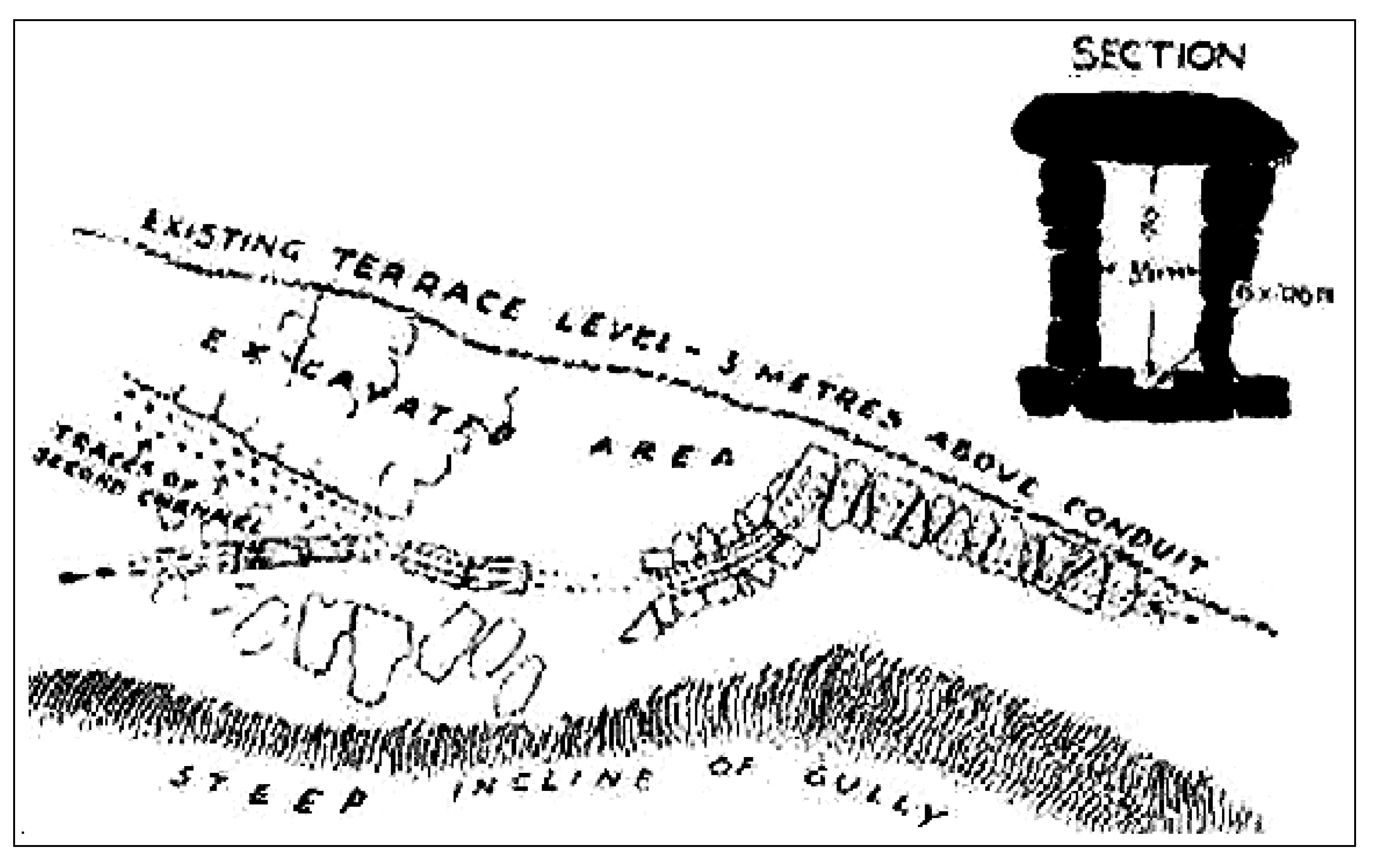
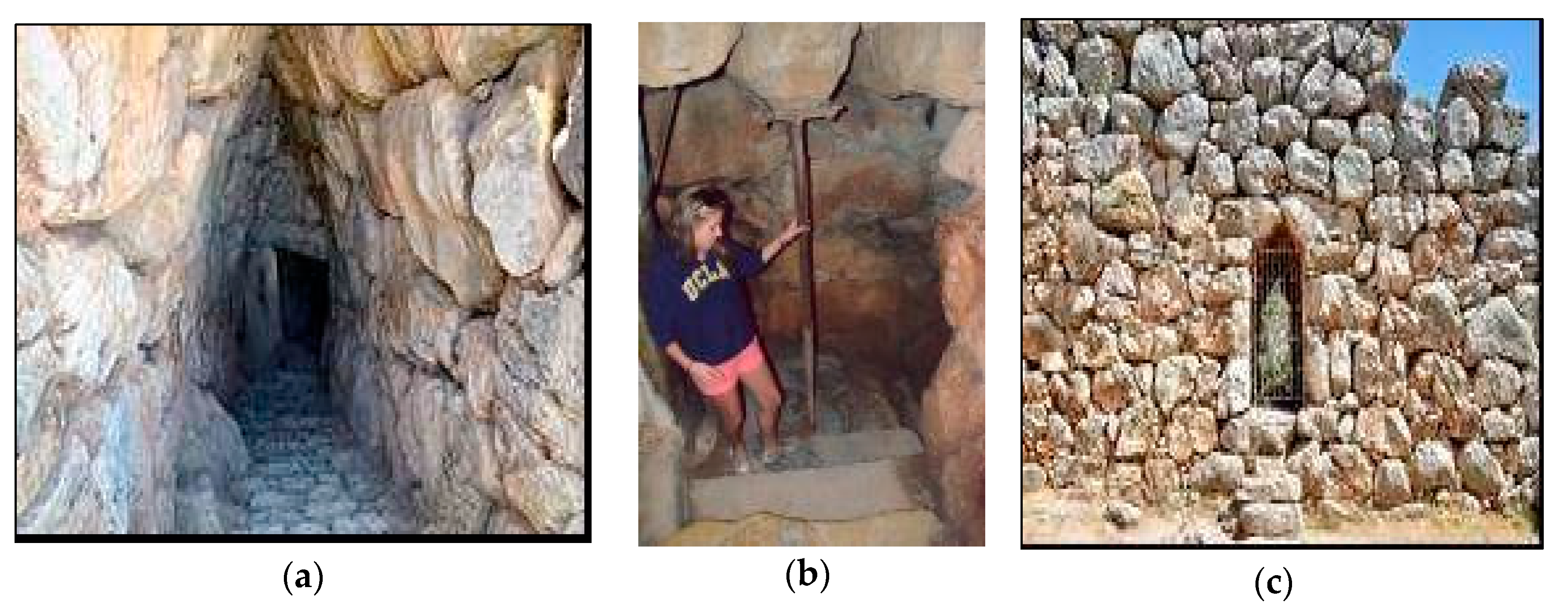
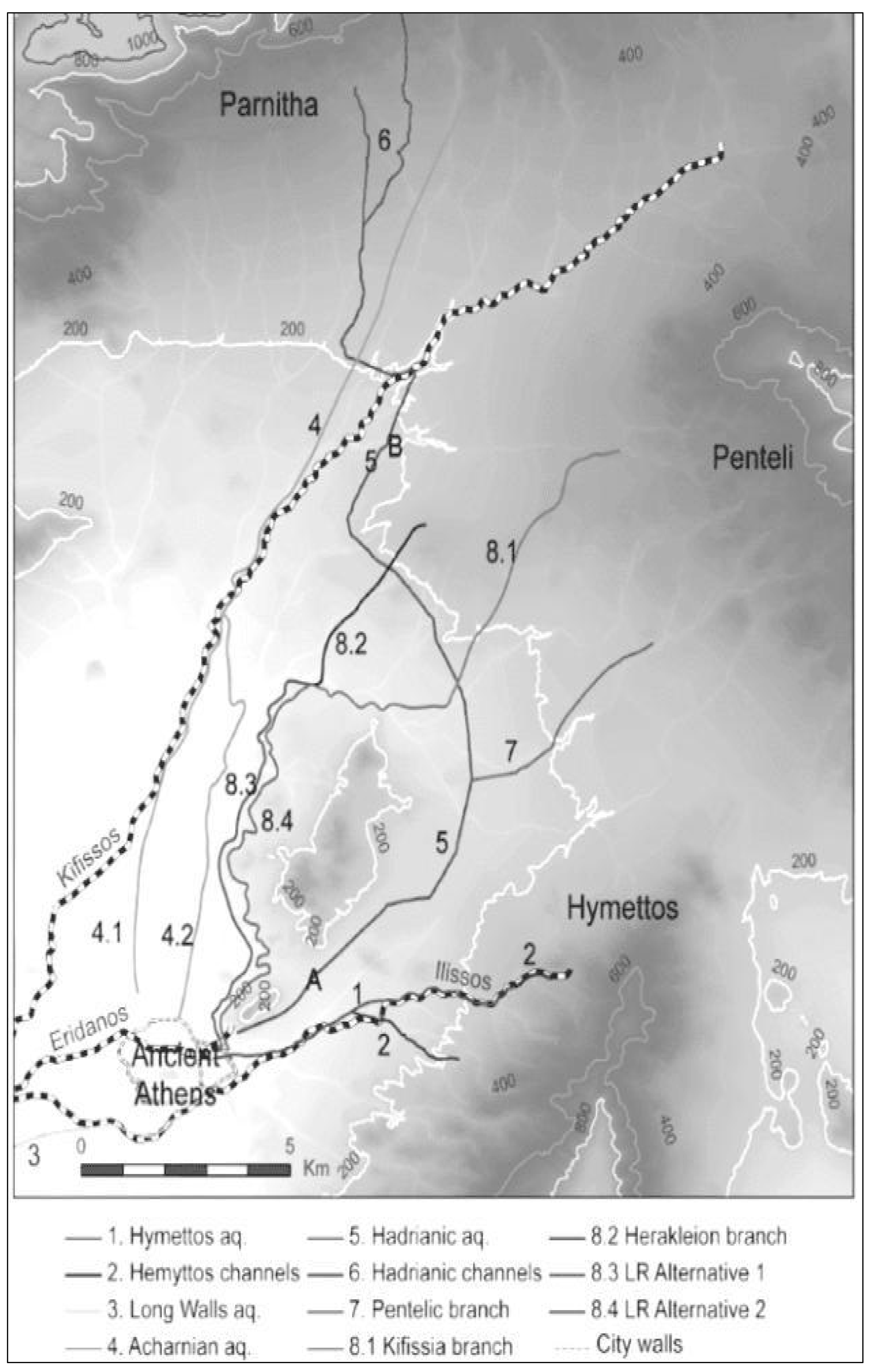


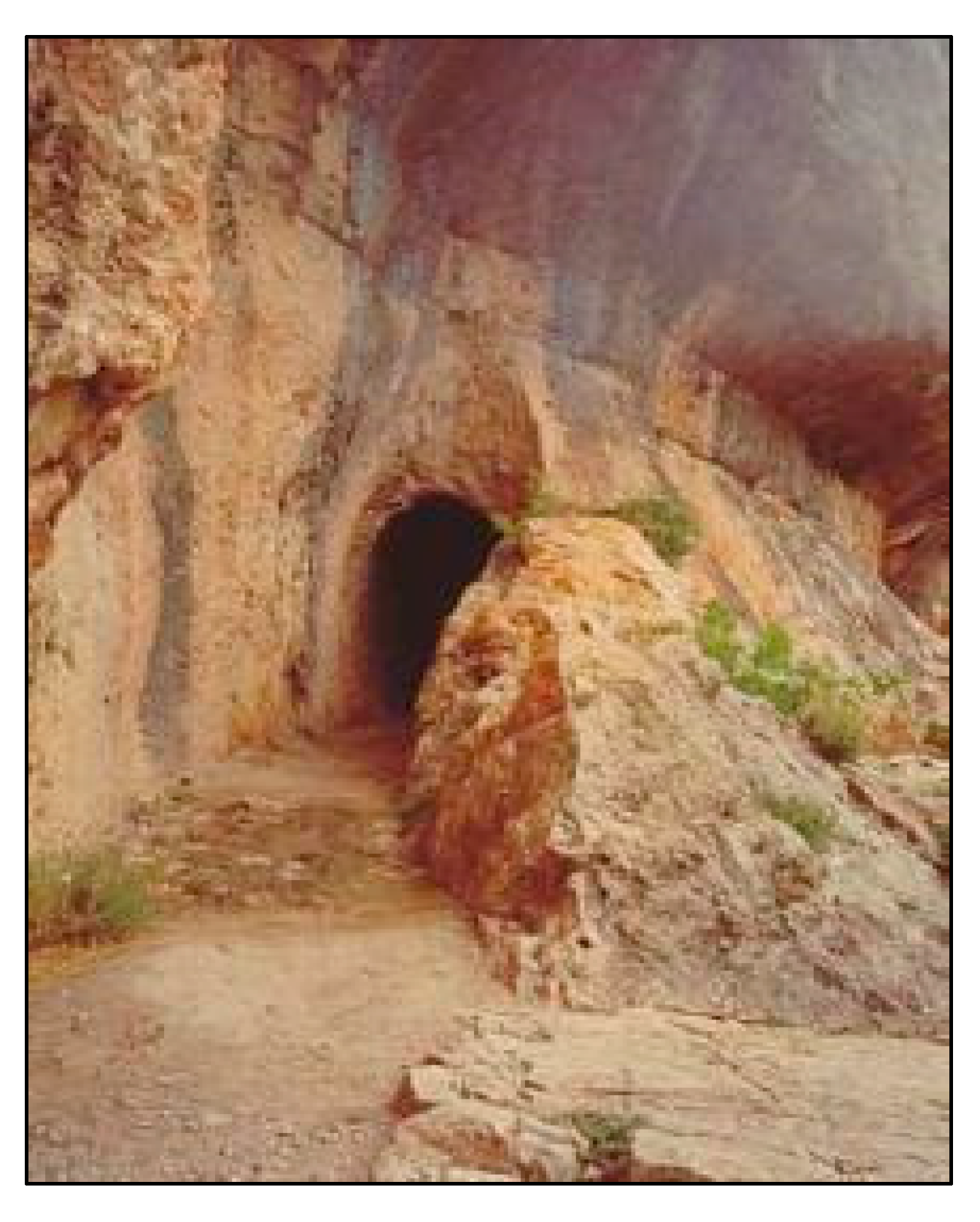
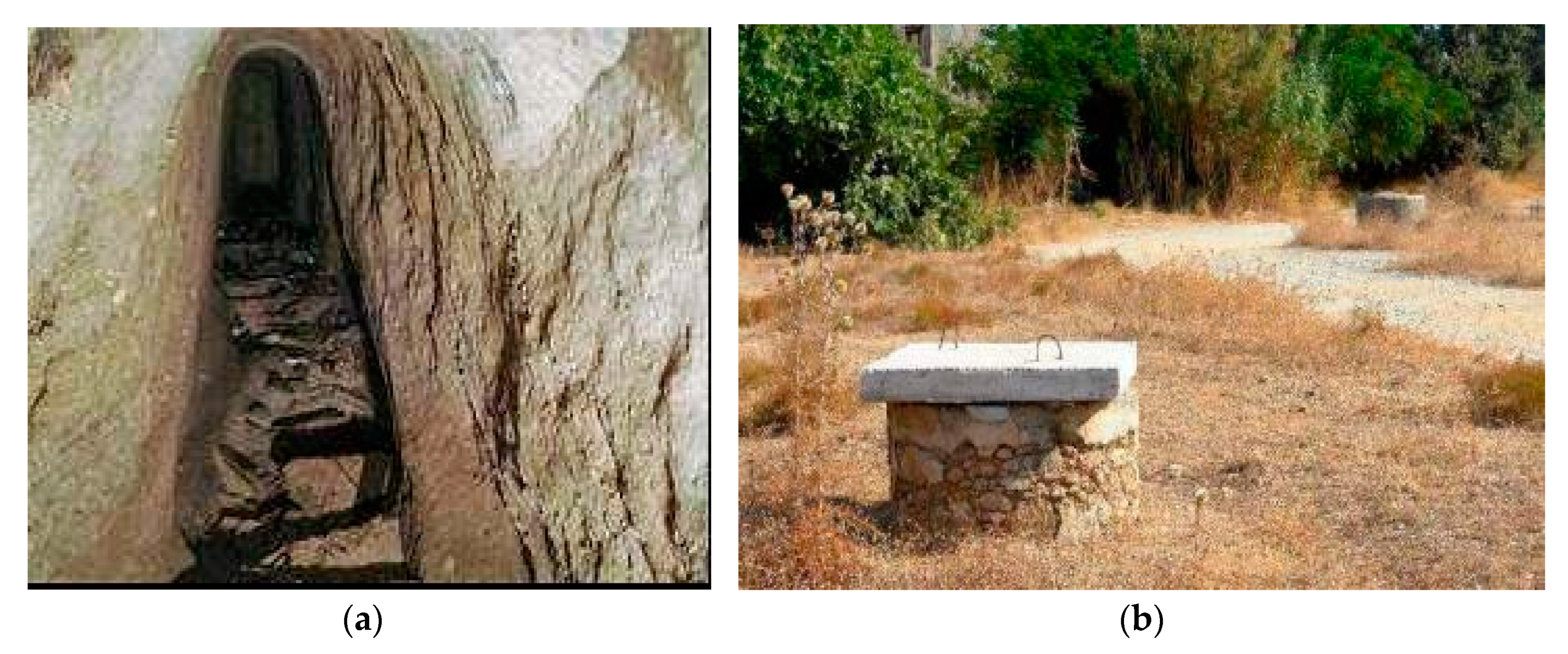
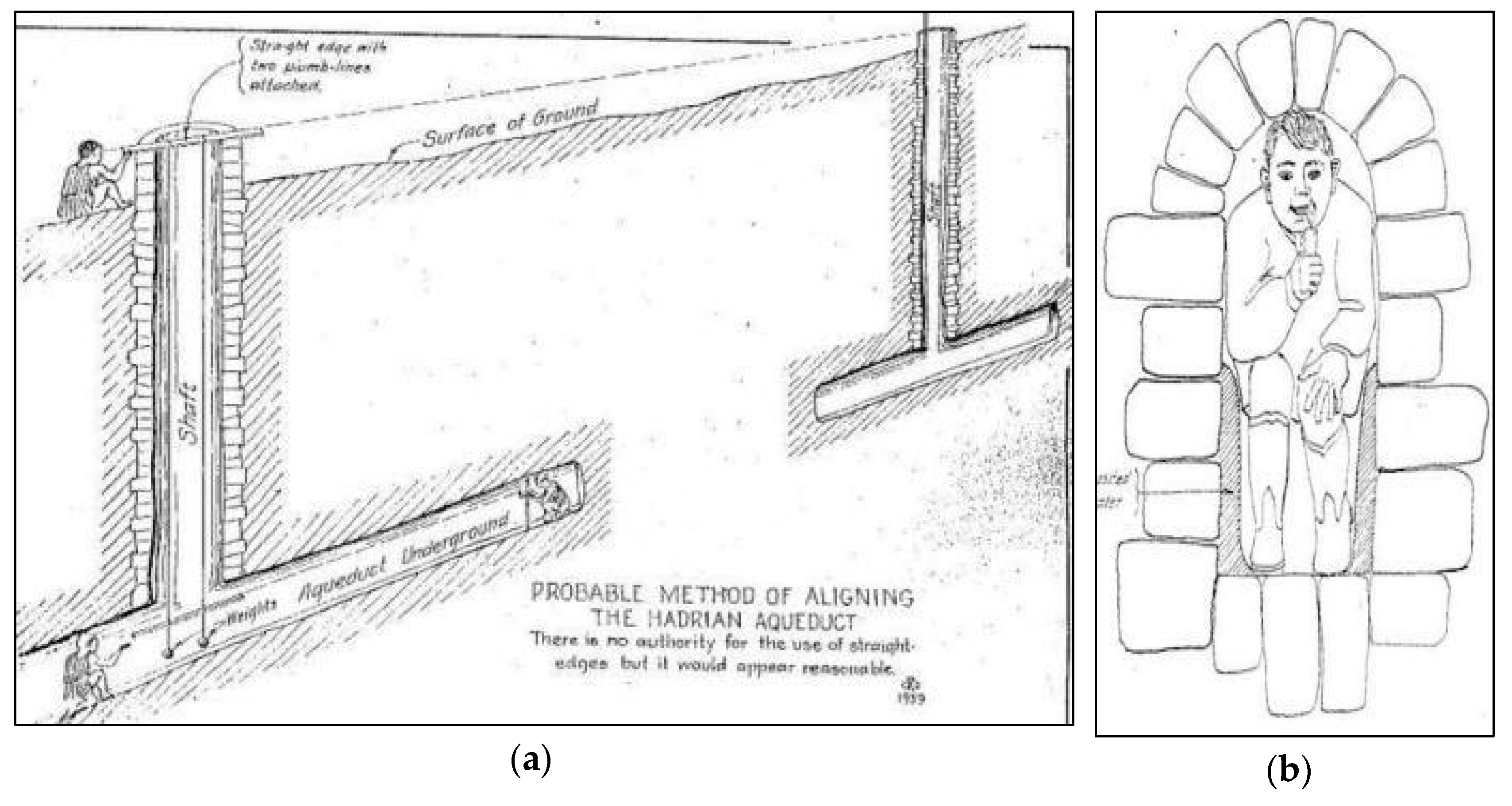
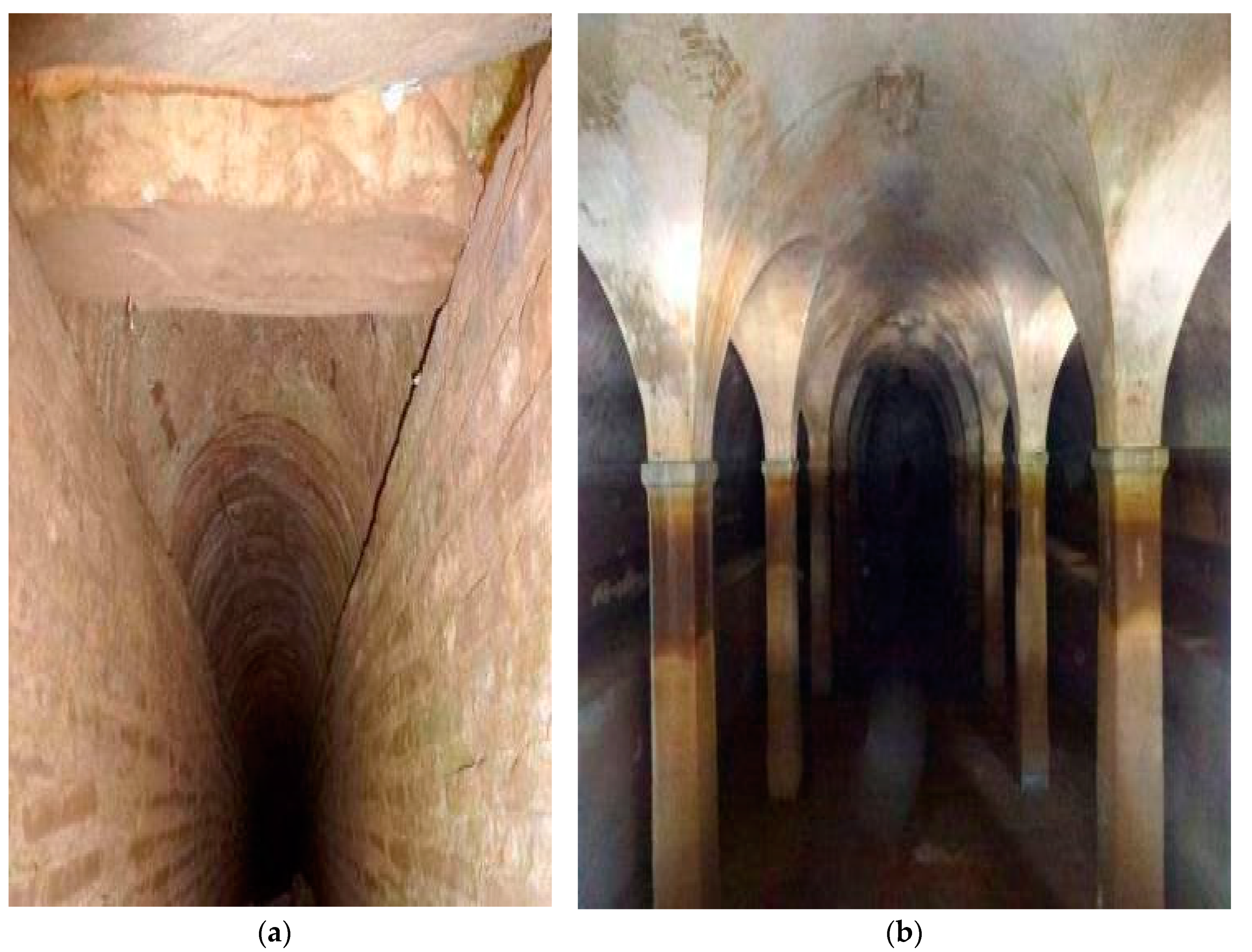


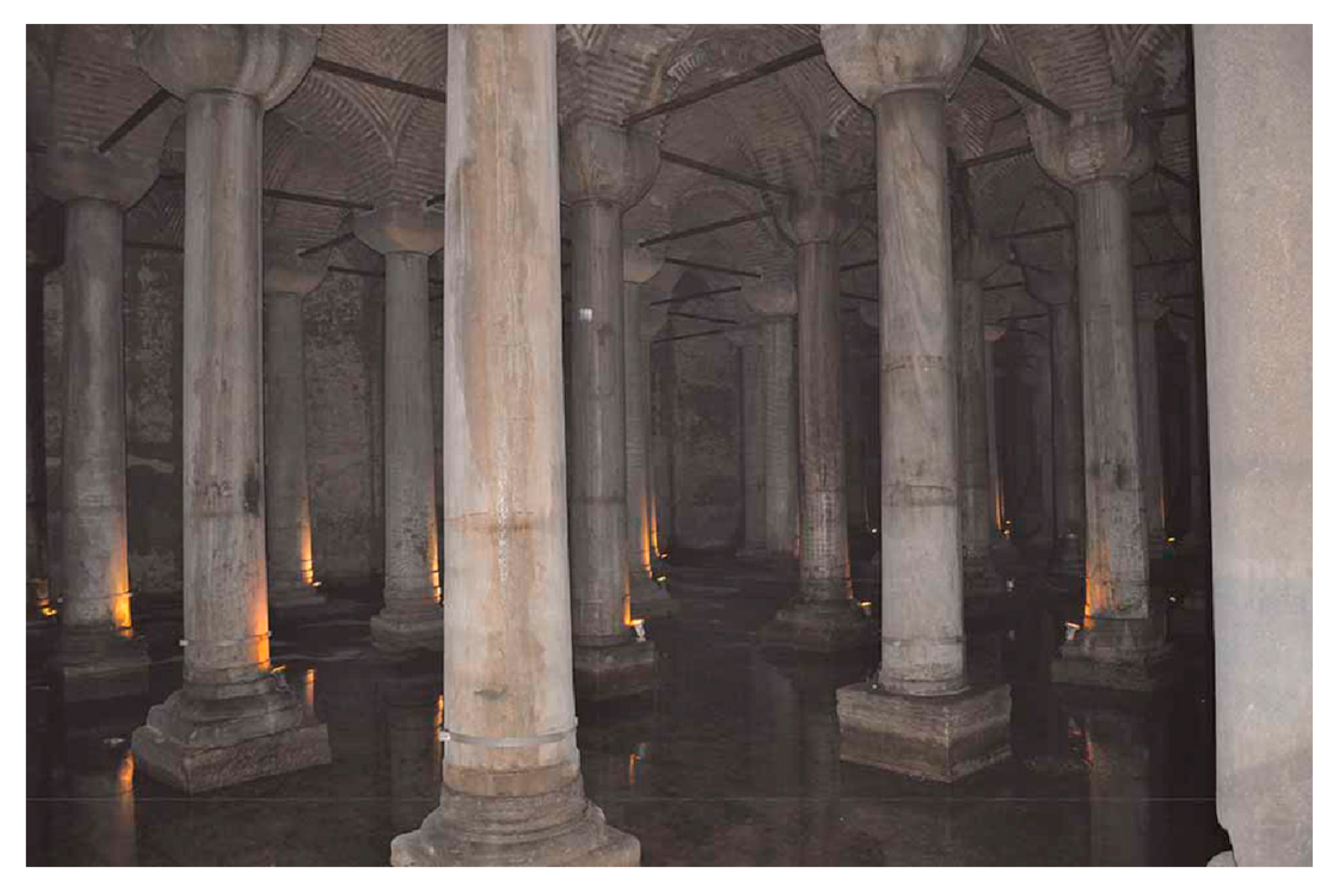


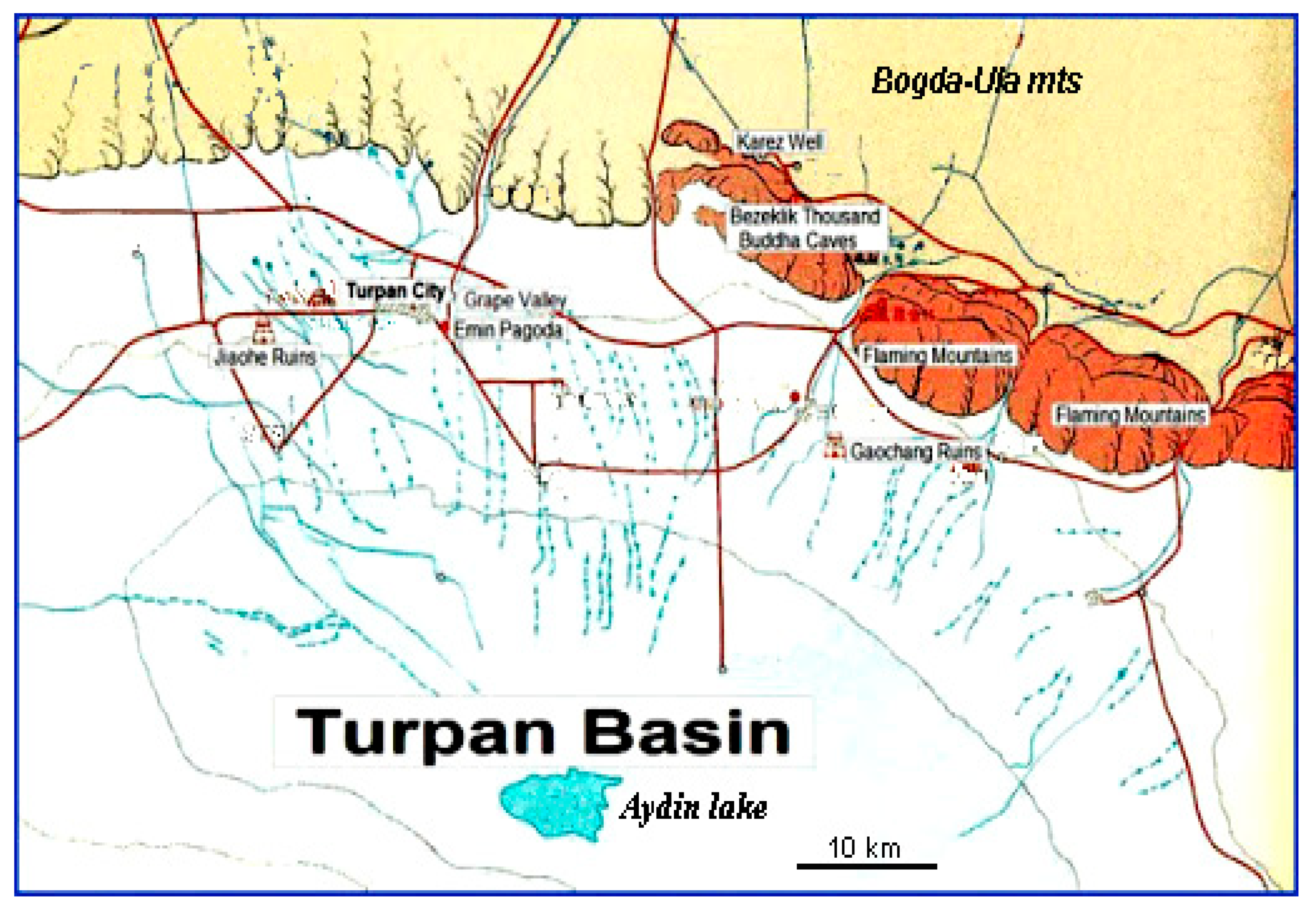


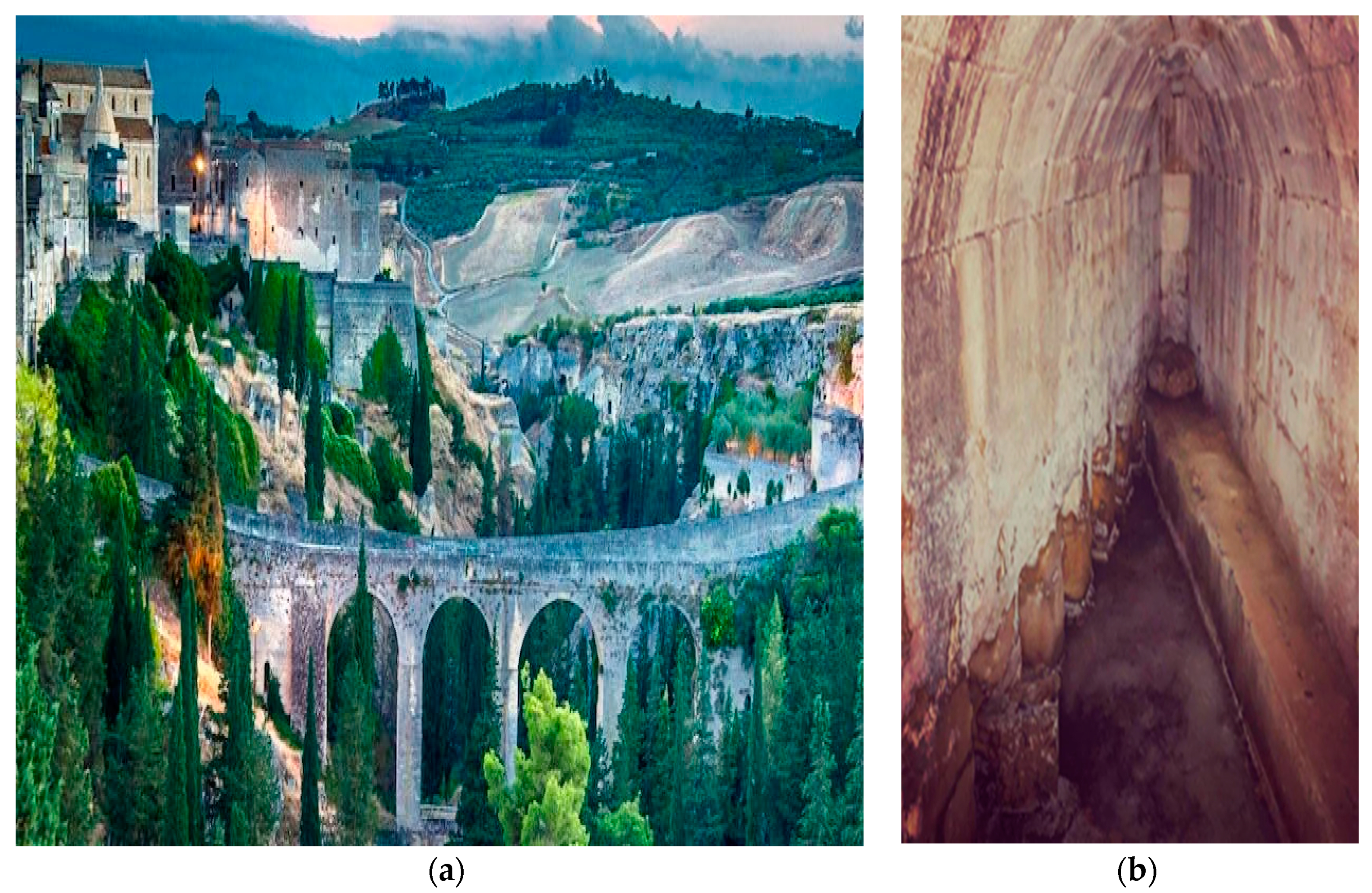
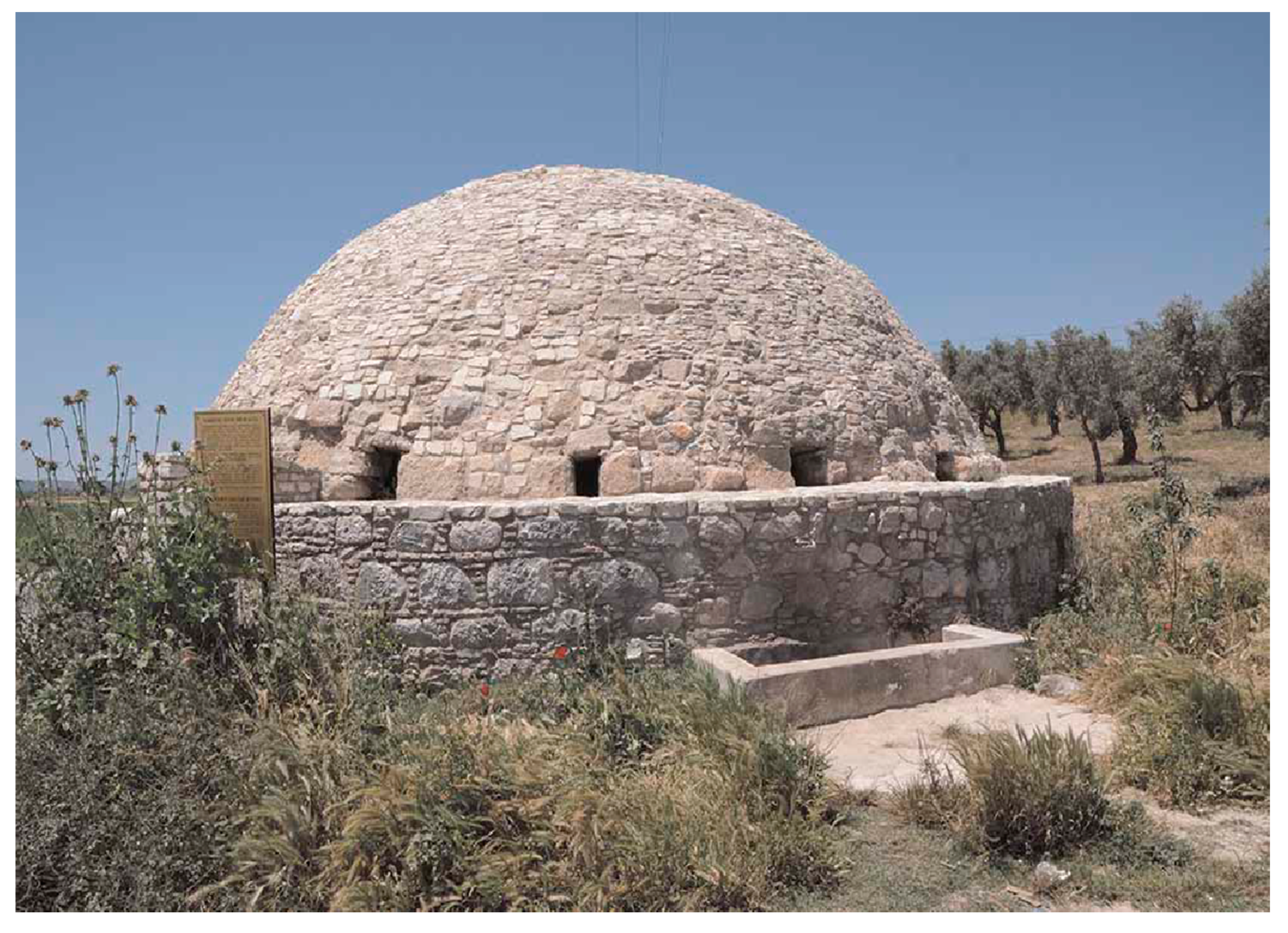




Publisher’s Note: MDPI stays neutral with regard to jurisdictional claims in published maps and institutional affiliations. |
© 2020 by the authors. Licensee MDPI, Basel, Switzerland. This article is an open access article distributed under the terms and conditions of the Creative Commons Attribution (CC BY) license (http://creativecommons.org/licenses/by/4.0/).
Share and Cite
Valipour, M.; Ahmed, A.T.; Antoniou, G.P.; Sala, R.; Parise, M.; Salgot, M.; Sanaan Bensi, N.; Angelakis, A.N. Sustainability of Underground Hydro-Technologies: From Ancient to Modern Times and toward the Future. Sustainability 2020, 12, 8983. https://doi.org/10.3390/su12218983
Valipour M, Ahmed AT, Antoniou GP, Sala R, Parise M, Salgot M, Sanaan Bensi N, Angelakis AN. Sustainability of Underground Hydro-Technologies: From Ancient to Modern Times and toward the Future. Sustainability. 2020; 12(21):8983. https://doi.org/10.3390/su12218983
Chicago/Turabian StyleValipour, Mohammad, Abdelkader T. Ahmed, Georgios P. Antoniou, Renato Sala, Mario Parise, Miquel Salgot, Negar Sanaan Bensi, and Andreas N. Angelakis. 2020. "Sustainability of Underground Hydro-Technologies: From Ancient to Modern Times and toward the Future" Sustainability 12, no. 21: 8983. https://doi.org/10.3390/su12218983





